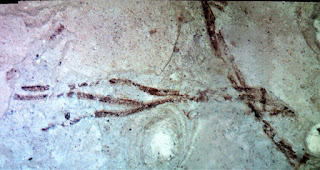 |
| Image courtesy of the Smithsonian Institution Specimen Catalog Number: USNM PAL 51268 Specimen GUID:
http://n2t.net/ark:/65665/3cffa9b15-4a41-4c0b-8664-be0c46084ecc Photographer Holly Little. Specimens housed in the collections of the Department of Paleobiology, National Museum of Natural History,
Smithsonian Institution | |
|
Recently, I gave a presentation about the 1889 book entitled Kentucky Fossil Shells by Henry Nettelroth (1835-1887) to a local geology group. During my presentation I brought up one of the snail fossils found called Platyceras dumosum (Conrad, 1840). They are found from time to time in Clark County, Indiana USA and Jefferson County, Kentucky USA. I consider them to be the porcupines of the Devonian sea with their array of long spines covering the whorled shell. Nettelroth had one illustrated plate XXIII just for these snail fossils. You can learn more about Henry Nettelroth in my December 3, 2022 posting about him.

In 1907, his two sons Herman and Alexander Nettelroth sold his prized fossil collection of about 8,000 specimens to the Smithsonian Institution and the U.S. National Museum. This collection was documented by Ray S. Bassler (1878-1961) in the 1908 publication of Smithsonian Miscellaneous Collections Vol. V Quarterly Issue Part 2 in an article "The Nettelroth Collection of Invertebrate Fossils".
Almost always the spines are broken off on these fossils and I wondered if the ones still at Smithsonian were still intact as shown in the plate illustration. So on December 21, 2020 I sent an e-mail to them asking if the fossil USNM PAL 51268 could be imaged. As it turns out 15 specimens were assigned to that number. To my surprise Mark Florence, Deputy Collections Manager Invertebrate Paleontology responded that they could image those fossils but the facility was on COVID-19 lockdown.
 |
| Image courtesy of the Smithsonian Institution Specimen Catalog Number: USNM PAL 51268 Specimen GUID:
http://n2t.net/ark:/65665/3cffa9b15-4a41-4c0b-8664-be0c46084ecc Photographer Holly Little. Specimens housed in the collections of the Department of Paleobiology, National Museum of Natural History,
Smithsonian Institution | |
COVID lasted a lot longer they I anticipated but they did not forget my request and on October 13, 2022 when they returned to the facility I was asked if the images were still needed. Later on December 22, 2022 I received a message from Mark Florence that a Smithsonian Institution's photographer Holly Little had imaged the fossils. Happily, images of those fossils have now been added to the Smithsonian National Museum of Natural History Department of Paleobiology Collections database at this link: https://collections.nmnh.si.edu/search/paleo/?ark=ark:/65665/3cffa9b154a414c0b8664be0c46084ecc
At our next geology group meeting, I hope to give an update to my group and show the images they took in comparison to the ones illustrated on the plate. I think the top image matches figure 3 in the original plate illustrated by Chas Starck of Louisville Lithographic Company. As pointed out in the recent e-mail from the Smithsonian, some of the spines had been broken off the original fossils.
A question I do have is why some of the fossils have green diamond shapes attached to them. I assume the ones attached to wooden boards where put on display at one time. It is nice to see fossils that were collected from the Louisville area 137-152 years ago and sent to Washington D.C. 116 years ago.












